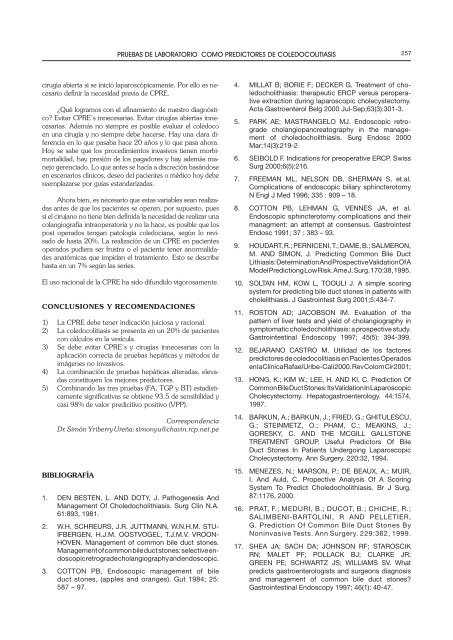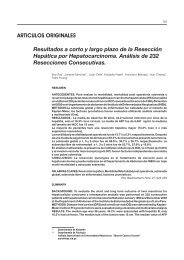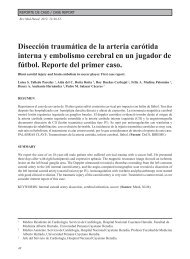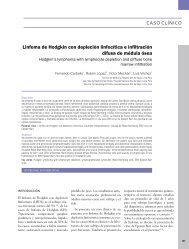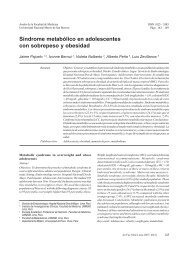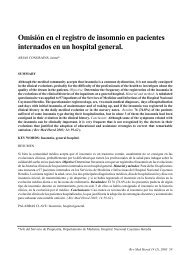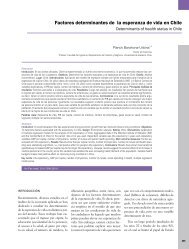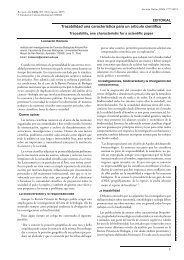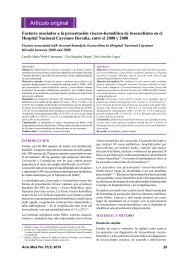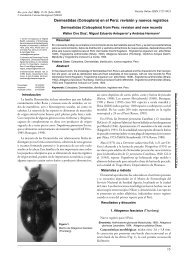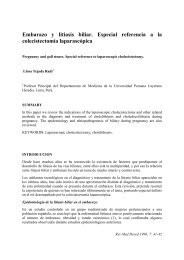REVISTA GASTRO 27-3.indd - SciELO
REVISTA GASTRO 27-3.indd - SciELO
REVISTA GASTRO 27-3.indd - SciELO
Create successful ePaper yourself
Turn your PDF publications into a flip-book with our unique Google optimized e-Paper software.
cirugía abierta si se inició laparoscópicamente. Por ello es necesario<br />
defi nir la necesidad previa de CPRE.<br />
¿Qué logramos con el afi namiento de nuestro diagnóstico?<br />
Evitar CPRE´s innecesarias. Evitar cirugías abiertas innecesarias.<br />
Además no siempre es posible evaluar el colédoco<br />
en una cirugía y no siempre debe hacerse. Hay una clara diferencia<br />
en lo que pasaba hace 20 años y lo que pasa ahora.<br />
Hoy se sabe que los procedimientos invasivos tienen morbimortalidad,<br />
hay presión de los pagadores y hay además manejo<br />
gerenciado. Lo que antes se hacía a discreción basándose<br />
en escenarios clínicos, deseo del pacientes o médico hoy debe<br />
reemplazarse por guías estandarizadas.<br />
Ahora bien, es necesario que estas variables sean realizadas<br />
antes de que los pacientes se operen, por supuesto, pues<br />
si el cirujano no tiene bien defi nida la necesidad de realizar una<br />
colangiografía intraoperatoria y no la hace, es posible que los<br />
post operados tengan patología coledociana, según lo revisado<br />
de hasta 20%. La realización de un CPRE en pacientes<br />
operados pudiera ser frustra o el paciente tener anormalidades<br />
anatómicas que impidan el tratamiento. Esto se describe<br />
hasta en un 7% según las series.<br />
El uso racional de la CPRE ha sido difundido vigorosamente.<br />
CONCLUSIONES Y RECOMENDACIONES<br />
1) La CPRE debe tener indicación juiciosa y racional.<br />
2) La coledocolitiasis se presenta en un 20% de pacientes<br />
con cálculos en la vesícula.<br />
3) Se debe evitar CPRE´s y cirugías innecesarias con la<br />
aplicación correcta de pruebas hepáticas y métodos de<br />
imágenes no invasivos.<br />
4) La combinación de pruebas hepáticas alteradas, elevadas<br />
constituyen los mejores predictores.<br />
5) Combinando las tres pruebas (FA, TGP y BT) estadísticamente<br />
signifi cativas se obtiene 93.5 de sensibilidad y<br />
casi 98% de valor predicitivo positivo (VPP).<br />
Correspondencia<br />
Dr. Simón Yriberry Ureña: simonyu@chavin.rcp.net.pe<br />
BIBLIOGRAFÍA<br />
PRUEBAS DE LABORATORIO COMO PREDICTORES DE COLEDOCOLITIASIS<br />
1. DEN BESTEN, L. AND DOTY, J. Pathogenesis And<br />
Management Of Choledocholithiasis. Surg Clin N.A.<br />
61:893, 1981.<br />
2. W.H. SCHREURS, J.R. JUTTMANN, W.N.H.M. STU-<br />
IFBERGEN, H.J.M. OOSTVOGEL, T.J.M.V. VROON-<br />
HOVEN. Management of common bile duct stones.<br />
Management of common bile duct stones: selective endoscopic<br />
retrograde cholangiography and endoscopic.<br />
3. COTTON PB, Endoscopic management of bile<br />
duct stones, (apples and oranges). Gut 1984; 25:<br />
587 – 97.<br />
257<br />
4. MILLAT B; BORIE F; DECKER G. Treatment of choledocholithiasis:<br />
therapeutic ERCP versus peroperative<br />
extraction during laparoscopic cholecystectomy.<br />
Acta Gastroenterol Belg 2000 Jul-Sep;63(3):301-3.<br />
5. PARK AE; MASTRANGELO MJ. Endoscopic retrograde<br />
cholangiopancreatography in the management<br />
of choledocholithiasis. Surg Endosc 2000<br />
Mar;14(3):219-2<br />
6. SEIBOLD F. Indications for preoperative ERCP. Swiss<br />
Surg 2000;6(5):216.<br />
7. FREEMAN ML, NELSON DB, SHERMAN S, et.al.<br />
Complications of endoscopic biliary sphincterotomy<br />
N Engl J Med 1996; 335 : 909 – 18.<br />
8. COTTON PB, LEHMAN G, VENNES JA, et al.<br />
Endoscopic sphincterotomy complications and their<br />
managment: an attempt at consensus. Gastrointest<br />
Endosc 1991; 37 : 383 – 93.<br />
9. HOUDART, R.; PERNICENI, T.; DAME, B.; SALMERON,<br />
M. AND SIMON, J. Predicting Common Bile Duct<br />
Lithiasis: Determination And Prospective Validation Of A<br />
Model Predictiong Low Risk. Ame J. Surg. 170:38, 1995.<br />
10. SOLTAN HM, KOW L, TOOULI J. A simple scoring<br />
system for predicting bile duct stones in patients with<br />
cholelithiasis. J Gastrointest Surg 2001;5:434-7.<br />
11. ROSTON AD; JACOBSON IM. Evaluation of the<br />
pattern of liver tests and yield of cholangiography in<br />
symptomatic choledocholithiasis: a prospective study.<br />
Gastrointestinal Endoscopy 1997; 45(5): 394-399.<br />
12. BEJARANO CASTRO M. Utilidad de los factores<br />
predictores de coledocolitiasis en Pacientes Operados<br />
en la Clínica Rafael Uribe-Cali 2000. Rev Colom Cir 2001;<br />
13. HONG, K.; KIM W.; LEE, H. AND KI, C. Prediction Of<br />
Common Bile Duct Stones: Its Validation In Laparoscopic<br />
Cholecystectomy. Hepatogastroenterology. 44:1574,<br />
1997.<br />
14. BARKUN, A.; BARKUN, J.; FRIED, G.; GHITULESCU,<br />
G.; STEINMETZ, O.; PHAM, C.; MEAKINS, J.;<br />
GORESKY, C. AND THE MCGILL GALLSTONE<br />
TREATMENT GROUP. Useful Predictors Of Bile<br />
Duct Stones In Patients Undergoing Laparoscopic<br />
Cholecystectomy. Ann Surgery. 220:32, 1994.<br />
15. MENEZES, N.; MARSON, P.; DE BEAUX, A.; MUIR,<br />
I. And Auld, C. Propective Analysis Of A Scoring<br />
System To Predict Choledocholithiasis. Br J Surg.<br />
87:1176, 2000.<br />
16. PRAT, F.; MEDURI, B.; DUCOT, B.; CHICHE, R.;<br />
SALIMBENI-BARTOLINI, R AND PELLETIER,<br />
G. Prediction Of Common Bile Duct Stones By<br />
Noninvasive Tests. Ann Surgery. 229:362, 1999.<br />
17. SHEA JA; SACH DA; JOHNSON RF; STAROSCIK<br />
RN; MALET PF; POLLACK BJ; CLARKE JR;<br />
GREEN PE; SCHWARTZ JS; WILLIAMS SV. What<br />
predicts gastroenterologists and surgeons diagnosis<br />
and management of common bile duct stones?<br />
Gastrointestinal Endoscopy 1997; 46(1): 40-47.


